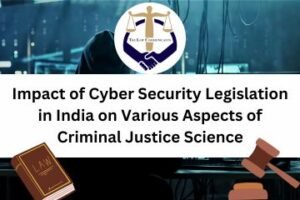Presumption Under the Indian Evidence Act
Written by: Ms Kajal Kumari
Introduction:
Stephen defines presumptions as it is a rule of law under which courts are authorized to draw a particular inference from a particular fact unless and until the truth of such inference is disproved by another evidence. This definition does not talk about permissive presumption but talks about mandatory presumption. In other words, presumptions mean things taken for granted. A presumption is not in itself evidence but only gives a prima facie case for the party in whose favour it exists.[1]
Section 4 of the Indian Evidence Act, 1872 provides that presumptions can be of three kinds:
- May Presume
- Shall Presume
- Conclusive Proof
May Presume is a discretionary presumption and it is the weakest category of presumption. According to section 4 of the Indian Evidence Act, 1872, whenever this is provided by this Act that the Court may presume a fact, the Court may, either regard such fact as proved unless and until it is disproved or may call for proof of it. Such as sections 90, 113A, 114 of the Indian Evidence Act, 1872.
Whenever it is directed by this Act, that the Court shall presume a fact, the Court shall presume such fact as proved unless and until it is disproved but the Court will not call for proof of such facts. This is a mandatory presumption. Such as sections 113B, 114A of the Indian Evidence Act, 1872.
May Presume and Shall Presume are also known as Rebuttable Presumption. Conclusive Proof and Conclusive Presumption is the strongest category of presumption and no evidence is allowed to disprove that fact. It is an Irrebuttable Presumption. Such as 82 of the Indian Penal Code, 1860, 41, 112, 115, 116, 117 of IEA, 1872.
Presumptions can also be categorized into a presumption of fact and a presumption of law.
Presumption as to Legitimacy:
Section 112 of the IEA, 1872 creates a rebuttable presumption of law as to the legitimacy of the child. The law presumes strongly in favour of legitimacy as it is birth that determines the status of the person.[2] This section embodies the rule of law that a child born during the continuance of a valid marriage or within 280 days of its dissolution, the mother remaining unmarried shall be conclusive proof that the child is legitimate.
The presumption of legitimacy can be overthrown by bringing clear and strong evidence that the husband and the wife had no access to each other at the time when the child could have been begotten. Therefore, the legitimacy of a child is determined from the time of birth and proof of non-access has to be given from the time of conception.
The principle underlying this section is that as a matter of public policy, it is undesirable to inquire into the paternity of a child whose parents ‘have access’ to each other.
The marriage can only be displaced/rebutted by conclusive proof of non-access and not by a mere balance of probabilities or any circumstance creating doubt. Section 112 of the Indian Evidence Act, 1872 has no application when maternity is in doubt and not paternity. Maternity is always a matter of fact and paternity is a matter of presumption.
Srimati Kanta Deer vs. Doshi Ram[3], The Supreme Court has laid down the following proposition:
- Section 112 of the IEA, 1872 which raises conclusive presumption about paternity of a child born during continuance of a valid marriage, itself provides an outlet to the party who wants to escape from the rigour of that conclusiveness. The said outlet is, if it can be shown that the parties had no access to each other at the time when the child could have been begotten.
- Non-access means opportunity for sexual intercourse it does not mean actual cohabitation.
Gautam Kundu vs. State of West Bengal 2001 SC, The Supreme Court has said that courts can not order any blood test or DNA test for the purpose of determining the legitimacy of a child. The purpose of section 112 of the Indian Evidence Act, 1872, is to confer legitimacy and not to inquire into the legitimacy of the child.
Nandlal Wasudew Badwaik vs. Lata Nandlal Badwaik, 2014 SC, the issue before the court was that when there is a scientific report (DNA Report) as to the legitimacy of a child and on the other hand the presumption under section 112 of the Indian Evidence Act, 1872, then the question arises as to which one will prevail over the other.
The Court held that although section 112 of the Indian Evidence Act, 1872 raises a presumption of conclusive proof on the satisfaction of the condition enumerated therein, the same presumption is rebuttable. The Court further observed that when the truth or the fact is known (DNA Test), there is no need or room for any presumption.
Therefore when there is a conflict between a conclusive proof envisaged under the law and proof-based upon scientific advancement accepted by the world to be correct, the latter must prevail over the former. The ratio of this case is not that courts can order DNA tests to determine legitimacy but it is merely that when the reports of scientific tests are present before the court the same can not be ignored as presumptions can not override bars fact.
Presumption as to abetment of suicide by a married woman:
Presumption as to abetment of suicide by a married woman covers under section 113A of the IEA, 1872. Essentials of section 113A of the IEA, 1872:
- Wife commits suicide;
- Accused- husband or relative of husband;
- Charge under section 306 of the Indian Penal Code, 1860 read with section 498A of the IPC, 1860;
- Suicide- within seven years of her marriage;
- You have to established section 498A of the IPC, 1860, which deals with cruelty;
- May Presume- discretionary in nature;
- Having regard to all the other circumstances of the case.[4]
If section 498A of the Indian Penal Code, 1860, is not shown or prima facie proved, the presumption under section 113A of the IEA, 1872 will not arise.
The burden of proof is on the husband, not on prosecution, it has shifted because of the presumption. It is for the husband to prove his innocence.
Presumption as to dowry death:
presumption as to dowry death covers under section 113B of the Indian Evidence Act, 1872. Essentials of section 113B of the Indian Evidence Act, 1872:
- Charge is under section 304B of the IPC, 1860;
- Soon before her death she was subjected to cruelty or harassment for or demand of dowry under section 498A of the IPC, 1860.
Difference between Section 113A and Section 113B of the Indian Evidence Act, 1872:
- Section 113A of the IEA, 1872: time, 7 years (committed suicide within 7 years), May Presume, Discretionary Presumption.
- Section 113B of the IEA, 1872: time, soon before her death, Shall Presume, Mandatory Presumption.[5]
Presumption as to the absence of Consent:
Presumption as to the absence of consent covers under section 114A of the Indian Evidence Act, 1872. Essentials of Section 114 A of the Indian Evidence Act, 1872:
- Charge is under section 376 of the IPC, 1860;
- Consent is in question;
- Sexual intercourse is proved;
- If the women says that it was non-consensual;
- Shall Presume.
Conclusion:
Presumptions are arbitrary annexations in law that obviate the necessity of proving a fact. When a court presumes a fact then there is no need to prove such fact. The operation of presumptions may be a largely unexplored area under the Indian Evidence Act, 1872. However, its application has huge consequences for the way during which we understand the ‘burden of proof’ of the prosecution and defence.
References:
[1] Prime Legal, ‘Presumption is not itself an evidence but only makes a prime facie case for a party for whose benefit it exists’ (LSI) <http://www.legalserviceindia.com/legal/article-4307-presumption-is-not-itself-an-evidence-but-only-makes-a-prime-facie-case-for-a-party-for-whose-benefit-it-exists.html#:~:text=Lawyers%20in%20India-,Presumption%20is%20not%20itself%20an%20evidence%20but%20o.> accessed 26 December 2020
[2] Chief Justice M. Monir, The Law of Evidence (Eighth Edition, Universal Law Publication Co.)
[3] AIR 2001 SC 2226
[4] Haripriya Vijayan ‘Presumptions Relating To Matrimonial Offences’ (LSI) <http://www.legalserviceindia.com/articles/pre_mat.htm> accessed 28 December 2020.
[5] Supra note 2
Previous Posts
Delhi’s Air Pollution Governance
Laws For Prevention Of Animal Cruelty
Constitutional Amendments in India
The Crypto Currency and Regulation of Official Digital Currency Bill, 2021




